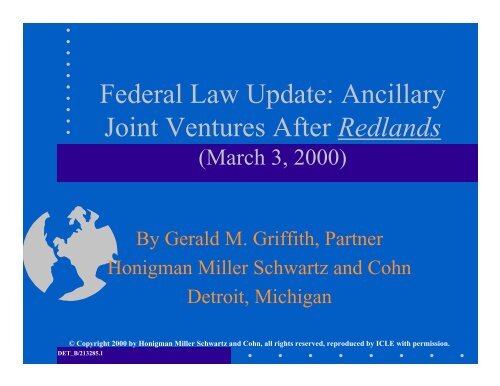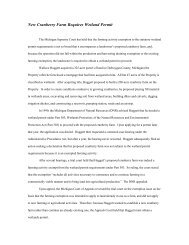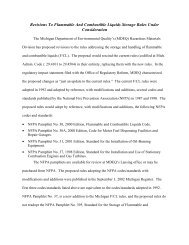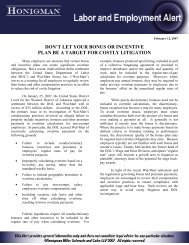Federal Law Update: Ancillary Joint Ventures After ... - Honigman
Federal Law Update: Ancillary Joint Ventures After ... - Honigman
Federal Law Update: Ancillary Joint Ventures After ... - Honigman
Create successful ePaper yourself
Turn your PDF publications into a flip-book with our unique Google optimized e-Paper software.
<strong>Federal</strong> <strong>Law</strong> <strong>Update</strong>: <strong>Ancillary</strong><br />
<strong>Joint</strong> <strong>Ventures</strong> <strong>After</strong> Redlands<br />
(March 3, 2000)<br />
By Gerald M. Griffith, Partner<br />
<strong>Honigman</strong> Miller Schwartz and Cohn<br />
Detroit, Michigan<br />
© Copyright 2000 by <strong>Honigman</strong> Miller Schwartz and Cohn, all rights reserved, reproduced by ICLE with permission.<br />
DET_B/213285.1
Major Developments for JVs<br />
• Audit Activity<br />
– UCC: Defining “Insiders”<br />
– TBOR2: Revenue Sharing<br />
• Whole Hospital <strong>Joint</strong> <strong>Ventures</strong><br />
– Rev. Rul. 98-15<br />
• Redlands Surgical Services<br />
– Sole activity<br />
– Control = inurement?
Areas not addressed<br />
• Non-tax considerations (e.g., Fraud and<br />
Abuse, Stark, Indenbaum, Antitrust)<br />
• Gainsharing (separate session)<br />
• UBI (no recent developments)<br />
• Bond-financed facilities (no developments<br />
of note since Rev. Procs. 97-13, 97-14 and<br />
97-15)
Audit Activity<br />
• Traditional EO and CEP Audits<br />
• IRS Coordination with Taxable Sector<br />
• TBOR2 Assessments (Sta-home Home<br />
Health, >$40 million)
Audit Activity<br />
• Ongoing joint venture audits<br />
• Common defects from the IRS perspective:<br />
– secretive process<br />
– lack of competitive bids<br />
– lack of “legitimate and rigorous” business<br />
investment analyses<br />
– failure to meet charity care and other covenants<br />
– diversion of funds for political intervention<br />
– lack of monitoring by nonprofit
Audit Activity<br />
• Community benefit factors (affected by<br />
control):<br />
– Is charity care actually provided and at what<br />
levels?<br />
– Are joint venture facilities located in an<br />
underserved, low-income area?<br />
– How does the community as a whole fare under<br />
the joint venture (e.g., in terms of access to and<br />
quality of services)?<br />
– Are decisions made based on the interests of the<br />
community or the interests of the for-profit?
Defining “Insiders”<br />
• No Free “First Bite” . . . or is there?<br />
– UCC I (Tax Court):<br />
• favorable terms of initial contract made fundraiser<br />
an insider<br />
• IRS’ self-fulfilling prophecy, must be insider based<br />
on favorable deal<br />
– UCC II (7th Cir.)<br />
• harshly critical of IRS and Tax Court<br />
• allows one free bite<br />
• passing reference to staff physicians as insiders<br />
– “DP” intended to be less inclusive than insiders
UCC: Functional Control Test<br />
• Functional test examining reality of control<br />
• Impact of UCC (7th Cir.):<br />
– Favorable terms alone may not show control<br />
– Distinguish control over entity vs. activity<br />
– Facts and circumstances is “no standard at all”<br />
• IRS may try to limit UCC to its facts now<br />
– Common type of arrangement (fundraising)<br />
– No control over actual “charitable activities”
TBOR2 Basics<br />
• Two-tier tax on disqualified persons<br />
receiving an excess benefit (25% + 200%)<br />
• Excess benefit includes<br />
– Receipt of more than fair market value<br />
– Revenue sharing (gross or net) resulting in<br />
inurement<br />
• Tax rate applies to amount of excess benefit<br />
– Excess over fair market value<br />
– Entire prohibited revenue sharing payment
Revenue Sharing Arrangements<br />
• Effective only after final Regs. are issued<br />
• Currently FMV limit applies<br />
• Facts and Circumstances Test:<br />
– proportionate benefit to EO and DP<br />
– relationship to quality and quantity of services<br />
– control of activities generating the revenues<br />
• No mention of a “cap” -- still helpful<br />
• Potentially affects all joint ventures
<strong>Ancillary</strong> <strong>Joint</strong> <strong>Ventures</strong><br />
•Two-prong Test<br />
• Rev. Rul. 98-15/Redlands<br />
– Management Contracts<br />
– Expanded Control Test<br />
– Community Benefit<br />
• Exemption Impact of 50/50 <strong>Ventures</strong><br />
• Unwinding <strong>Joint</strong> <strong>Ventures</strong><br />
• Other Structuring Options
Two-prong Test<br />
• Derived from Plumstead Theatre and GCM 39005; same for<br />
partnerships and LLCs electing partnership treatment<br />
• (1): does participation further an exempt purpose of the<br />
nonprofit?<br />
• (2): does the nonprofit have duties to its proprietary partners<br />
(e.g., maximize profits) that would prevent the nonprofit<br />
from acting exclusively in furtherance of its exempt<br />
purposes? (Historically: 50% control and other GPs)<br />
• Corollary: protection against the nonprofit’s assets being<br />
used for partnership liabilities (e.g., no unlimited capitals<br />
calls and adequate insurance)
Typical Whole Hospital <strong>Joint</strong> Venture<br />
Nonprofit<br />
Foundation<br />
For-profit<br />
Hospital Co.<br />
50/50 split of<br />
profits and<br />
board seats<br />
Wholly owned<br />
subsidiary<br />
LLC Operating<br />
Hospital<br />
Management<br />
Contract<br />
For-profit<br />
Management<br />
Co.
Rev. Rul. 98-15<br />
• Examples at two extremes of control<br />
• Key distinguishing factors for Situation 1:<br />
– EO must have >50% of board votes<br />
– <strong>Joint</strong> venture profit motive must be<br />
subordinated to charitable purposes<br />
– Management contract must be of reasonable<br />
duration<br />
– Manager and top administrators must be<br />
independent of for-profit partner
<strong>Ancillary</strong> Services <strong>Joint</strong> Venture (Hospital)<br />
Nonprofit<br />
Hospital<br />
Physicians or<br />
For-profit<br />
Management<br />
Contract<br />
50/50 split of<br />
profits and<br />
board seats<br />
LLC or<br />
Partnership
<strong>Ancillary</strong> Services <strong>Joint</strong> Venture (Hospital Subsidiary)<br />
Nonprofit<br />
Hospital<br />
Wholly owned<br />
subsidiary<br />
Management<br />
Services Co.<br />
Physicians or<br />
For-profit<br />
Management<br />
Contract<br />
50/50 split of<br />
profits and<br />
board seats<br />
LLC or<br />
Partnership
Redlands<br />
Community<br />
Hospital<br />
Foundation<br />
<strong>Ancillary</strong> Services <strong>Joint</strong> Venture (Redlands Final Structure)<br />
Redlands Health<br />
Systems, Inc.<br />
Redlands<br />
Community<br />
Hospital<br />
30 RCH Staff<br />
Physicians and<br />
Clinic (LPs)<br />
Redlands<br />
Surgical<br />
Services<br />
QA Service<br />
Contract<br />
41% profits<br />
interest<br />
Inland Surgery<br />
Center, L.P.<br />
46/54 profits<br />
and 50/50 board<br />
59% profits<br />
interest<br />
(SCIA/Investors)<br />
Redlands-SCA<br />
Surgery Centers,<br />
Inc.<br />
Redlands Ambulatory<br />
Surgery Center (GP)<br />
Management<br />
Contract<br />
Wholly<br />
owned<br />
subsidiary<br />
SCA<br />
Management<br />
Co.
<strong>Ancillary</strong> Services <strong>Joint</strong> <strong>Ventures</strong><br />
• IRS likely to apply Rev. Rul. 98-15<br />
• Issue is control of contributed charitable<br />
assets<br />
• Exemption denial upheld by Tax Court in<br />
Redlands; appeal pending (9th Circuit)<br />
• PLR due out Dec. 1999 delayed pending<br />
Redlands and now TBOR2 final regulations<br />
• IRS may limit to UBI if not whole hospital
Redlands: Why Not Exempt?<br />
• Sole purpose: ASC joint venture with for-profit<br />
• 50/50 board of General Partnership<br />
– veto rights only (for both parties)<br />
– no initiation rights for RSS<br />
• No other influence for RSS<br />
– physicians owned stock in SCIA<br />
– no active supervision by RCH<br />
• Partnership Agreements fail to mention primacy of<br />
charitable motives
Redlands: Why Not Exempt?<br />
• High returns vs. losses at RCH outpatient dept.<br />
• SCA subsidiary as manager with broad authority<br />
– 25 year no cut management contract<br />
– Compensation: 6% of collectable revenues + expenses<br />
– No clear incentive for charity care/Medicaid services<br />
• Arbitration with no requirement to consider<br />
community benefit<br />
• No pure charity care (as opposed to bad debt)<br />
• Negligible Medicaid (
Redlands: Why Not Exempt?<br />
• RSS was a shell<br />
– Minimal QA and other activities (contract terminated)<br />
– No employees or paid officers<br />
• Zero community need; could not support 2nd ASC<br />
• Noncompetition covenant with RSS and Hospital<br />
– Eliminated price competition<br />
– Avoided pressure to upgrade equipment<br />
• No proof RSS had any impact on proprietary<br />
operations of ASC<br />
• Education programs at ASC insufficient
Expanded Control Test<br />
• Veto power over all actions at JV board<br />
– Exception if purely medical<br />
– What is purely medical?<br />
• Reserved Powers for (c)(3)’s community board<br />
– capital and operating budget and variations over $X<br />
– sale of assets over $X<br />
– incur, assume or guaranty debt over $X<br />
– dissolution, merger, consolidation, sale of substantially all assets<br />
– amendment of the joint venture agreement and governance documents<br />
– affiliations or joint ventures with others<br />
– contracts with for-profit partner(s)<br />
– discontinuance, reduction or termination of service line or location<br />
– discontinuance of Medicare/Medicaid participation<br />
– appointment and removal of management personnel and manager
Expanded Control Test<br />
• Initiation Rights (in lieu of true majority control)<br />
– Scope of services offered and locations<br />
– Charity care<br />
• Use HFMA definition to exclude bad debt<br />
• Note: Partners can be protected by limiting JV’s charity care to<br />
the same percentage of total revenues as hospital<br />
– Managed care contracts<br />
– Meaningful termination rights for management agreement<br />
with for-profit partner (for cause or, after reasonable<br />
initial term, without cause)<br />
– Open staff policies<br />
– Dissolution if exemption at risk (or Medicare/Medicaid)<br />
– Monitoring and audit rights
Management Contracts<br />
• Select Mgr. unrelated to for-profit partners<br />
• Charity care/Medicaid: minimum standards and a factor in<br />
any incentive compensation formula<br />
• Require Mgr. to follow community benefit goals<br />
• Cap percentage compensation (still Fraud & Abuse risk)<br />
• Reasonable term and termination provisions:<br />
– reasonable initial term (follow Rev. Proc. 97-13, term is a<br />
function of compensation methodology)<br />
– mutual agreement for renewal<br />
– terminable at least for cause without terminating JV<br />
– termination rights exercisable by nonprofit alone
Community Benefit<br />
•New services<br />
• Substantial charity care, Medicaid, Medicare<br />
• Remedy shortage and other access problems<br />
• Communicate charity care policy to community<br />
• General oversight by nonprofit’s community<br />
board<br />
• CON reflecting community need
Exemption Impact of 50/50 <strong>Ventures</strong><br />
• Concerns are exemption, TBOR2, UBI (and bonds)<br />
• Non-issue if insubstantial part of total activities and<br />
partners are not insiders<br />
• Is control over charitable assets is a substantial<br />
private benefit? (See Rev. Rul. 98-15/Redlands)<br />
• If yes, how is providing that same benefit to<br />
insiders not inurement per se and only a UBI issue?
Exemption Impact of 50/50 <strong>Ventures</strong><br />
• Possible alternatives for a change in IRS<br />
interpretation:<br />
– change/clarify definition of who is an insider<br />
– clarify insubstantial inurement is only TBOR2<br />
– if it is not the nonprofit’s sole activity, control of joint<br />
venture is not tantamount to control of the entity and not<br />
a substantial private benefit, so veto rights are enough if<br />
eliminate some “bad facts” of Rev. Rul. 98-15/Redlands<br />
(e.g., charity care/Medicaid standards, unrelated Mgr.)<br />
• Caution: The IRS has not clarified which, if any,<br />
alternative applies or how many bad facts must go
Unwinding <strong>Joint</strong> <strong>Ventures</strong><br />
• Exit strategies negotiated in advance are key<br />
– Unscrambling the egg: FMV payments to compensate<br />
for lost programs<br />
– Put/buy-out right upon adverse tax event<br />
• Partner/manager may now be insider and DP<br />
– Unwind can result in inurement or excess benefit<br />
– Adjust historical results for future circumstances<br />
without partner (e.g., lose key HMO contract?)<br />
• IRS entertaining closing agreement requests (a la<br />
GCM 39862): valuation and control are key
Other Structuring Options<br />
• Taxable subsidiary<br />
– Moline Properties: respect separate corp. identity<br />
– JCT would require disclosure of returns<br />
• Investment<br />
– No management role, truly passive<br />
– Comparable returns for the risk<br />
• Charitable donation<br />
– Requires specific control over use of contributions<br />
– Unlikely to apply in traditional joint ventures
Other Structuring Options<br />
• Insubstantial portion of activities--UBI only<br />
– No joint ventures with insiders<br />
– IRS favorably inclined, no rulings pending appeal<br />
• not involve substantially all assets<br />
• reverse one or more bad facts of Rev. Rul. 98-<br />
15/Redlands (e.g., charity care and Medicaid at same<br />
levels as hospital, independent management company<br />
with a more reasonable contract)<br />
• unclear how many “bad facts” must become “good<br />
facts”
Non-tax Considerations<br />
• Antifraud Statute<br />
– Gainsharing Special Advisory Bulletin<br />
(reference to clinical joint ventures)<br />
– New safe harbors: 64 Fed. Reg. 63517 (Nov.<br />
19, 1999)<br />
•Stark <strong>Law</strong><br />
• Indenbaum/16221 (“Stark on steroids”)<br />
• Antitrust





